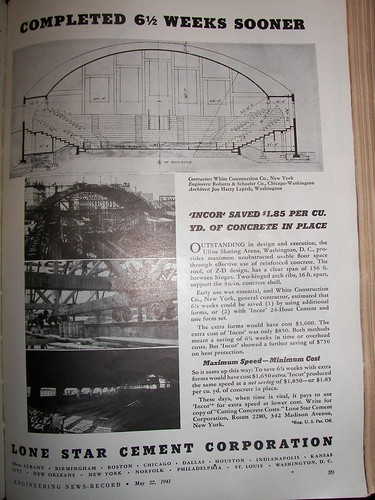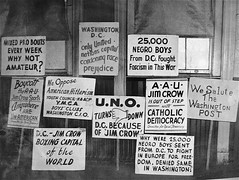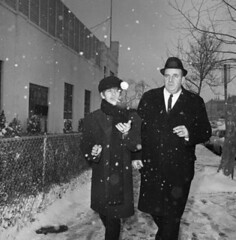Uline Arena landmarked
 Lone Star Cement ad, discussing the Uline Arena construction process, Engineering News-Record, May 22, 1941.
Lone Star Cement ad, discussing the Uline Arena construction process, Engineering News-Record, May 22, 1941.The Uline Arena was added to the DC Inventory of Historic Sites by the Historic Preservation Review Board today in an 8-0 vote. The property owner, Douglas Development, did not contest the nomination, although they questioned the inclusion of one particular lot in the site (812), which is not really a part of the Uline Ice Manufacturing Plant and Arena Complex.
------------
People who assisted the preparation of the original nomination include Justine Christianson of the Historic American Engineering Record, Kate Farnham, Alan Kimber, Drew Ronneberg, Tanya Callaway, David Bell, Jim Schulman, Sheila White, Farleigh Earhart, and Krista Gebbia. And probably others that I've forgotten since the nomination was first filed in June 2003.
DC Preservation League was the applicant of record. Near Northeast Citizens passed a resolution to file the nomination, but it was determined that the organization didn't have standing under the relevant laws and regulations in DC (neighborhood organizations have to list preservation as a goal or objective in the organization's bylaws or articles).
Justine's presentation, based on her paper which appeared in Washington History in 2004, and at the 2004 DC Historical Studies Conference, was the basis of today's presentation.
-----------
Last week's City Paper has a nice piece on the building, in Dave McKenna's Cheapseats column. See "Arena Football."
The staff report on the nomination is particularly good. One thing that needs to be further researched is the place the desegregation of the Uline Arena holds in the quest for Civil Rights in the city, and nationally.
Before the Arena was desegregated in 1948, only the Central Library and the transit system were fully integrated places. In 1953, public accommodations (restaurants, hotels, theaters, arenas) were integrated as a result of the campaign by the "Coordinating Committee for the Enforcement of the D.C. Anti-Discrimination Laws," which culminated in a case that went to the Supreme Court, District of Columbia v. John R. Thompson Co. And of course, in 1954, Brown v. Board of Education (which included the local case Bolling v. Sharpe) brought about the integration of public schools. (Also see, "Before Montgomery and Greensboro: The Desegregation Movement in the District of Columbia, 1950 - 1953.")
 Protest Signs, Campaign to integrate Uline Arena.
Protest Signs, Campaign to integrate Uline Arena.Dr. Edwin B. Henderson led the campaign to desegregate the Uline, which is discussed at some length in the journal article by George Mason University professor David Wiggins, "Edwin Bancroft Henderson: physical educator, civil rights activist, and chronicler of African American athletes" (Research Quarterly for Exercise and Sport; 1999 Jun;70(2):91-112). Of course, it would be useful to know what the state of integration of such arenas was in other major cities around the same time, to be able to better place this event in the national context.
And this is in addition to the architectural history, and the association with other historical figures and events, including, yes, the Beatles first concert in North America.
It's a good thing that a few days ago I added a link to the Recent Past Preservation Network in the right sidebar, because the Uline Arena is a perfect example of early modernism, and form following function with little adornment.
Tonight is the Annual Meeting of the DC Preservation League as well.
 Ringo Starr on 3rd Street NE. Caption: 11 Feb 1963, Washington, DC, USA --- British rock star and member of The Beatles, Ringo Starr tosses a snowball as he walks in the snow outside the Washington Coliseum where he will perform tonight. --- Image by © Bettmann/CORBIS.
Ringo Starr on 3rd Street NE. Caption: 11 Feb 1963, Washington, DC, USA --- British rock star and member of The Beatles, Ringo Starr tosses a snowball as he walks in the snow outside the Washington Coliseum where he will perform tonight. --- Image by © Bettmann/CORBIS.Index Keywords: historic-preservation



1 Comments:
Thank you for providing such valuable information and thanks for sharing this Business Promotion technique.
Post a Comment
<< Home